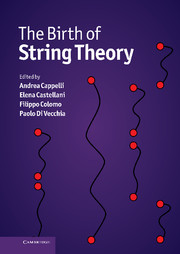Book contents
- Frontmatter
- Contents
- List of contributors
- Photographs of contributors
- Preface
- Abbreviations and acronyms
- Part I Overview
- EARLY STRING THEORY
- Part II The prehistory: the analytic S-matrix
- Part III The Dual Resonance Model
- Part IV The string
- TOWARDS MODERN STRING THEORY
- Part V Beyond the bosonic string
- Part VI The superstring
- Part VII Preparing the string renaissance
- 42 Introduction to Part VII
- 43 From strings to superstrings: a personal perspective
- 44 Quarks, strings and beyond
- 45 The rise of superstring theory
- Appendix A Theoretical tools of the Sixties
- Appendix B The Veneziano amplitude
- Appendix C From the string action to the Dual Resonance Model
- Appendix D World-sheet and target-space supersymmetry
- Appendix E The field theory limit
- Index
43 - From strings to superstrings: a personal perspective
from Part VII - Preparing the string renaissance
Published online by Cambridge University Press: 05 May 2012
- Frontmatter
- Contents
- List of contributors
- Photographs of contributors
- Preface
- Abbreviations and acronyms
- Part I Overview
- EARLY STRING THEORY
- Part II The prehistory: the analytic S-matrix
- Part III The Dual Resonance Model
- Part IV The string
- TOWARDS MODERN STRING THEORY
- Part V Beyond the bosonic string
- Part VI The superstring
- Part VII Preparing the string renaissance
- 42 Introduction to Part VII
- 43 From strings to superstrings: a personal perspective
- 44 Quarks, strings and beyond
- 45 The rise of superstring theory
- Appendix A Theoretical tools of the Sixties
- Appendix B The Veneziano amplitude
- Appendix C From the string action to the Dual Resonance Model
- Appendix D World-sheet and target-space supersymmetry
- Appendix E The field theory limit
- Index
Summary
Abstract
This Chapter gives an overview of my period of research in string theory up to the end of 1984. I will begin with my time as a graduate student and postdoc, which coincided with the earliest developments in dual models and string theory. However, I will not repeat the detailed history of this early period, which is covered much more completely by other authors in this Volume. The second part will concern the development of string theory with manifest spacetime supersymmetry in the late Seventies and early Eighties, a period that postdates most of the other contributions in this Volume.
String theory till 1979
The subject of string theory has its genesis in the many wonderful developments in relativity and quantum theory in the first half of the twentieth century. Two singular results of the early to mid-Sixties are particularly relevant to subsequent developments in string theory. One of these was the formulation by Dirac of a theory of the relativistic membrane [Dir62] (eight years before the formulation of the relativistic string, Nambu and Goto [Nam70, Got71]), in which he attempted to describe the μ-meson as a radial excitation of a spherical membrane whose ground state was the electron. This inspired paper was effectively ignored until the subject of supermembranes became fashionable in the late Eighties. It now plays a key role, in association with Born and Infeld's long-neglected nonlinear electrodynamics [BI34], in the Dirac–Born–Infeld description of D-branes. A second important insight of the mid-Sixties was Hagedorn's implementation of the bootstrap programme.
- Type
- Chapter
- Information
- The Birth of String Theory , pp. 527 - 543Publisher: Cambridge University PressPrint publication year: 2012
- 2
- Cited by



